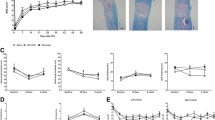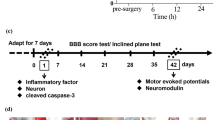Abstract
The chronic phase of spinal cord injury (SCI) is the most challenging to treat. The extension of disrupted axons is necessary for prominent motor function recovery. Our previous studies demonstrated that diosgenin had remarkable potential for axonal growth activity. This study investigated the effects of an intrathecal infusion of diosgenin in spinal cord-injured mice to evaluate motor function and axonal density during the chronic phase. Female ddY mice received an L1 spinal cord injury (SCI). Thirty-one days after the injury, the chronic intrathecal infusion was started. The infusion was sustained for 59 days, and motor function was evaluated using the Basso Mouse Scale, Toyama Mouse Score, and vertical cage scale through the dosing period and endpoint. 5-HT-positive raphespinal tracts were quantified in the lesion center, rostral and caudal positions 2 mm away from the center. The intrathecal infusion of diosgenin significantly improved hind limb motor function and density of the raphespinal tracts in the lesion center. The glial scar size did not differ between the vehicle-treated and diosgenin-treated groups. Cultured medulla oblongata neurons and spinal cord neurons on CSPG-coating extended axons by treatment with diosgenin. Diosgenin is a potential candidate as a therapeutic drug for chronic SCI.




Similar content being viewed by others
REFERENCES
Tran, A.P., Warren, P.M., and Silver, J., Physiol. Rev., 2018, vol. 98(2), pp. 881–917.
Xie, F., and Zheng, B., Exp. Neurol., 2008, vol. 209(2), pp. 302–312.
Wang, D., Ichiyama, R.M., Zhao, R., Andrews, M.R., and Fawcett, J.W., J. Neurosci., 2011, vol. 31(25), pp. 9332–9344.
Nori, S., Khazaei, M., Ahuja, C.S., Yokota, K., Ahlfors, J.E., Liu, Y., Wang, J., Shibata, S., Chio, J., Hettiaratchi, M.H., Führmann, T., Shoichet, M.S., and Fehlings, M.G., Stem Cell Reports, 2018, vol. 11(6), pp. 1433–1448.
Tohda, C, Urano, T., Umezaki, M., Nemere, I., and Kuboyama, T., Sci. Rep., 2012, vol. 2, p. 535.
Tohda, C., Lee, Y.A., Goto, Y., and Nemere, I., Sci. Rep., 2013, vol. 3, p. 3395.
Yang, X., and Tohda, C., Sci.Rep., 2018, vol. 8, p. 11707.
Kikuchi, T., Suyama, M., and Tohda, C., Sci. Rep., 2020, vol. 10, p. 19475.
Casaca-Carreira, J., Temel, Y., Hescham, S.A., and Jahanshahi, A., Mol. Neurobiol., 2018, vol. 55, pp. 2780–2788.
Basso, D.M., Fisher, L.C., Anderson, A.J., Jakeman, L.B., McTigue, D.M., and Popovich, P.G., J. Neurotrauma., 2006, vol. 23, pp. 635–659.
Shigyo, M., Tanabe, N., Kuboyama, T., Choi, S.H., and Tohda, C., BMC Res. Notes, 2014, vol. 7, p. 332.
Teshigawara, K., Kuboyama, T., Shigyo, M., Nagata, A., Sugimoto, K., Matsuya, Y., and Tohda, C., Br. J. Pharmacol., 2013, vol. 168, pp. 903–919.
Ruschel, J., Hellal, F., Flynn, K.C., Dupraz, S., Elliott, D.A., Tedeschi, A., Bates, M., Sliwinski, C., Brook, G., Dobrindt, K., Peitz, M., Brüstle, O., Norenberg, M.D., Blesch, A., Weidner, N., Bunge, M.B., Bixby, J.L., and Bradke, F., Science, 2015, vol. 348, pp. 347–352.
Shigyo, M., and Tohda, C., Sci. Rep., 2016, vol. 6, p. 28293.
Tashiro, S., Nishimura, S., Iwai, H., Sugai, K., Zhang, L., Shinozaki, M., Iwanami, A., Toyama, Y., Liu, M., Okano, H., and Nakamura, M., Sci. Rep., 2016, vol. 6, p. 30898.
Tanabe, N., Kuboyama, T., and Tohda, C., Neural. Regen. Res., 2019, vol.14(11), pp. 1961–1967.
Bouchard, J.F., Horn, K.E., Stroh, T., and Kennedy, T.E., J. Neurochem., 2008, vol. 107, pp. 398–417.
Aigner, L., Arber, S., Kapfhammer, J.P., Laux, T., Schneider, C., Botteri, F., Brenner, H.R., and Caroni, P., Cell, 1995, vol. 83, pp. 269–278.
Verma, P., Chierzi, S., Codd, A.M., Campbell, D.S., Meyer, R.L., Holt, C.E., and Fawcett, J.W., J. Neurosci., 2005, vol. 25, pp. 331–342.
Shi, S.H., Jan, L.Y., and Jan, Y.N., Cell, 2003, vol. 112, pp. 63–75.
Atwal, J.K., Massie, B., Miller, F.D., and Kaplan, D.R., Neuron, 2000, vol. 27, pp. 265–277.
Campbell, D.S., and Holt, C.E., Neuron, 2003, vol. 37, pp. 939–952.
Data sheet of LIORESAL® INTRATHECAL. https://www.accessdata.fda.gov/drugsatfda_docs/label/2016/020075s032lbl.pdf.
ACKNOWLEDGMENTS
We would like to thank Editage (www.editage.jp) for English language editing.
Funding
This study was supported by a JSPS KAKENHI Grant (Number JP17H03558) and discretionary funds of the President of the University of Toyama in 2018 and 2019.
Author information
Authors and Affiliations
Corresponding author
Ethics declarations
Conflict of interest. The authors declare that they have no competing interests.
Ethical approval. All experiments were performed following the Guidelines for the Care and Use of Laboratory Animals of the Sugitani Campus of the University of Toyama. All protocols were approved by the Committee for Animal Care and Use of the Sugitani Campus of the University of Toyama. The approval number for animal experiments was A2016INM-3 and A2019INM-3. All efforts were made to minimize the number of animals used.
Supplementary Information
Rights and permissions
About this article
Cite this article
Nakano, A., Yang, X., Kuboyama, T. et al. Intrathecal Infusion of Diosgenin during the Chronic Phase of Spinal Cord Injury Ameliorates Motor Function and Axonal Density. Neurochem. J. 15, 454–461 (2021). https://doi.org/10.1134/S1819712421040085
Received:
Revised:
Accepted:
Published:
Issue Date:
DOI: https://doi.org/10.1134/S1819712421040085




